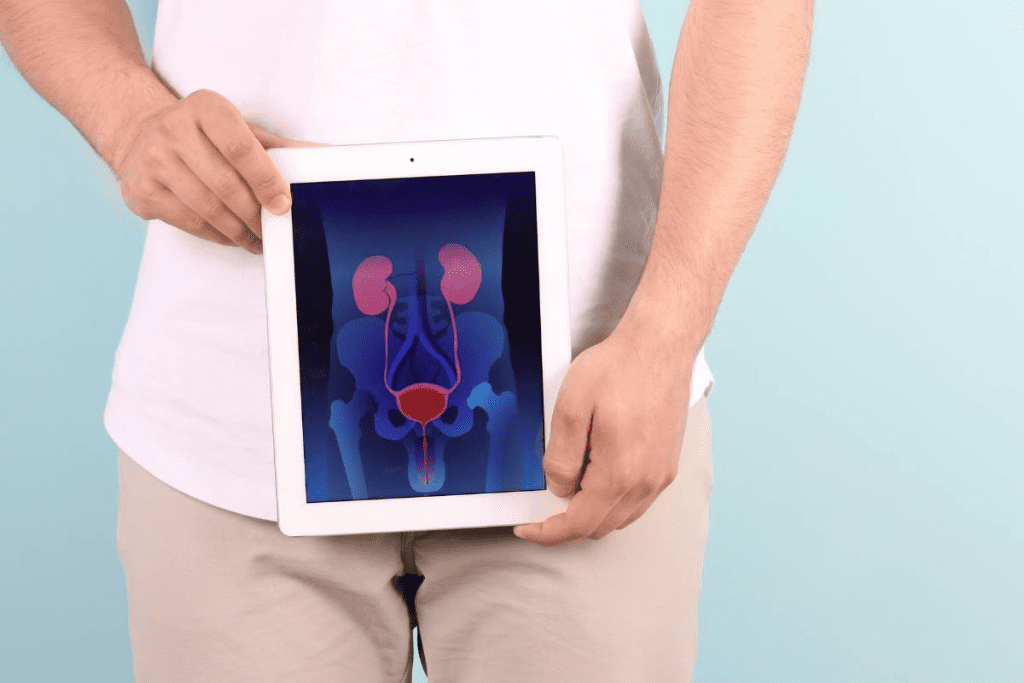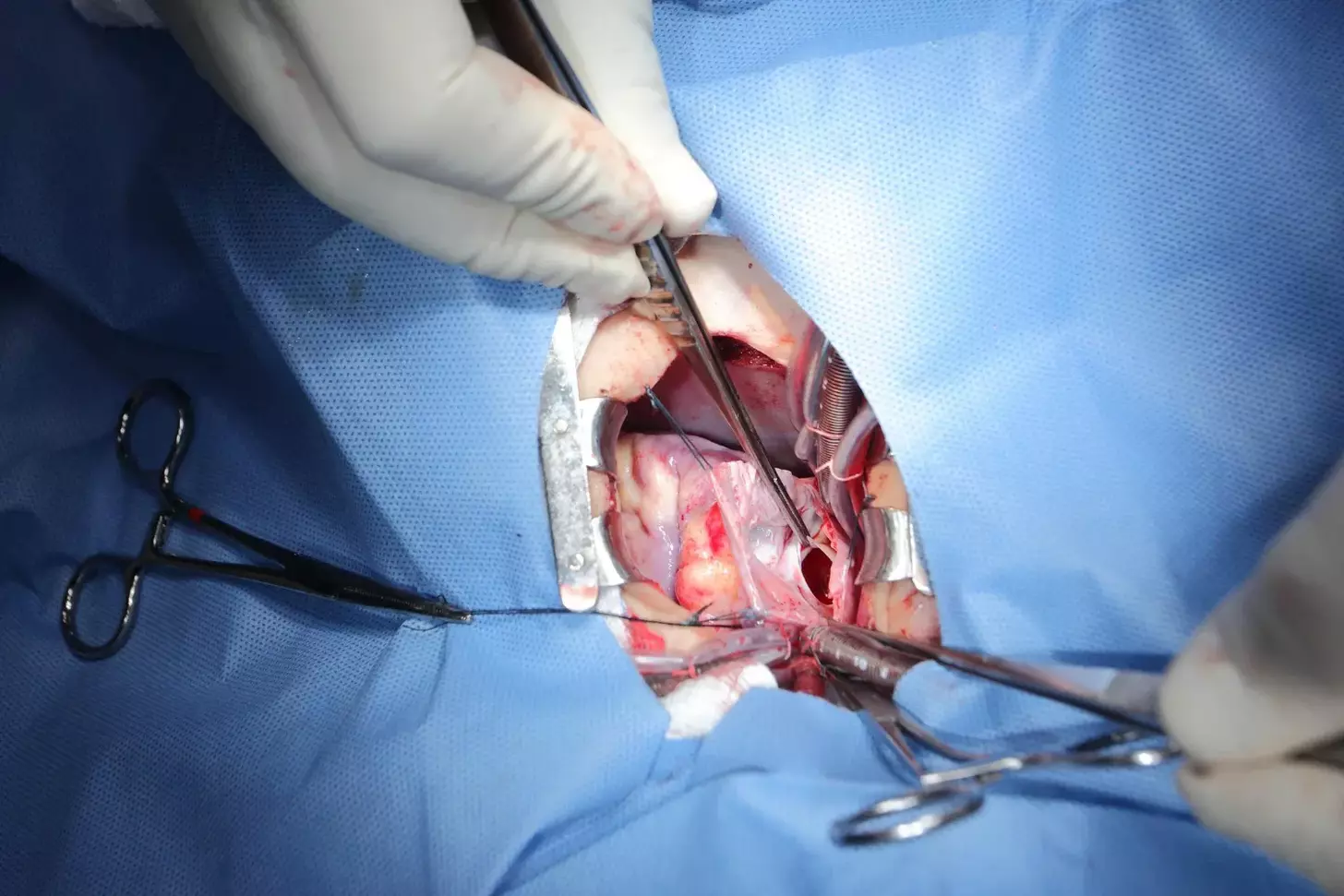Last Updated on November 26, 2025 by Bilal Hasdemir

The digital rectal exam (DRE) has been key in prostate cancer screening for years. Even with new tech, it’s vital in urology. A recent talk about its use has raised questions.
A doctor uses a gloved, lubricated finger in the rectum to check the prostate. It’s quick and simple, but some question its accuracy and comfort. Many men worry about the prostate finger exam. Some even hesitate to talk about prostate issues with their doctor because of this fear.
Key Takeaways
- The DRE is a traditional method for prostate cancer screening.
- Its accuracy is limited as it can only feel the back portion of the prostate.
- Modern diagnostic pathways now often involve PSA tests followed by MRI scans for more accurate results.
- The DRE may also be used for diagnosing non-cancerous conditions like benign prostatic hyperplasia (BPH).
- Patient anxiety around the DRE is significant, affecting some men’s willingness to discuss prostate health.
The History of Prostate Examinations
The history of prostate exams shows how far we’ve come in finding and treating cancer. Cancer is a big killer worldwide, often because it’s found too late. This makes early detection very important.
Early Detection Methods for Prostate Issues
In the early 1900s, finding prostate problems was hard. The Digital Rectal Exam (DRE) was a big step forward. It lets doctors feel problems in the prostate.
The DRE has been key in finding prostate cancer early. It helps doctors spot issues before symptoms show up. PSA testing later added to this, making prostate health checks even better.
Evolution of Prostate Screening Techniques
Prostate screening has gotten better over time. New tech and methods have made it more accurate and comfortable for patients. Medical imaging and biomarker tests have helped doctors diagnose better.
| Decade | Significant Advancements in Prostate Screening |
| 1940s | Introduction of Digital Rectal Exam (DRE) |
| 1980s | PSA testing becomes available |
| 2000s | Advances in MRI technology for prostate imaging |
A urologist, said, “The progress in prostate screening is amazing. Each step helps find and treat cancer sooner.” This shows the hard work to make prostate exams better.
Using different screening methods has made finding prostate problems early easier. This has greatly improved treatment results. As science keeps improving, prostate screening will likely get even better and more tailored to each person.
Understanding the Digital Rectal Exam (DRE) Procedure
The prostate finger check, also known as a digital rectal exam, is a simple procedure. It gives important insights into prostate health. Doctors use it to check the prostate gland for any problems.
The Prostate Finger Check Method Explained
A healthcare provider inserts a gloved, lubricated finger into the patient’s rectum. This lets doctors feel the prostate gland. They check its size, shape, and texture for any irregularities.
Key aspects of the DRE procedure include:
- The use of a gloved finger to ensure hygiene and comfort
- Lubrication to reduce discomfort during the examination
- A gentle and careful insertion of the finger into the rectum
- Palpation of the prostate gland to check for abnormalities
What Doctors Feel For During Manual Examination
Doctors check several things during the manual examination. They look at the prostate gland’s size, shape, and texture. They also check for any nodules or irregularities.
| Characteristic | Normal Finding | Abnormal Finding |
| Size | About the size of a walnut | Enlarged or irregular size |
| Shape | Symmetrical | Asymmetrical or irregular shape |
| Texture | Smooth and rubbery | Hard, lumpy, or tender |
The information from a DRE is key for diagnosing prostate issues. This includes prostate cancer, prostatitis, and BPH. While it’s not a definitive test for prostate cancer, it’s a big part of checking the prostate.
In conclusion, the digital rectal exam is a valuable tool for doctors. It helps them understand the prostate gland better. Knowing about the procedure can help patients feel less anxious and improve their prostate health.
Current Medical Practice: Do Doctors STILL Perform Finger Exams?
Even with new medical tech, the DRE is a key tool in healthcare today. It helps doctors check the prostate and find problems early.
Statistics on DRE Usage in Modern American Healthcare
Research shows DRE is common in urology and primary care. Many doctors use it to check patients.
- A survey of urologists found that over 80% use DRE in first checks.
- In primary care, DRE is a first step to find prostate issues.
- How often DRE is used changes based on age, risk, and medical history.
Variations in Practice Across Different Medical Settings
DRE use varies in different places. This depends on:
- Specialty clinics: Urology clinics use DRE more than general practice.
- Patient population: Those at high risk, like those with prostate cancer family history, get DRE more often.
- Geographic location: Where you live can also change how DRE is used.
The DRE’s ongoing use in healthcare shows its importance. It’s a key part of caring for patients, even if used differently in different places.
The Medical Rationale Behind Manual Prostate Checks

Understanding why manual prostate checks are important is key. The digital rectal exam (DRE) lets doctors check the prostate gland directly. This gives them vital information for diagnosing and planning treatment.
Physical Characteristics Detectable Only by Touch
A DRE lets doctors feel the prostate gland’s size, consistency, and tenderness. For example, if the prostate feels hard or irregular, it could mean a tumor or other problem.
Being able to feel these details is important. It can show issues that blood tests or scans might miss. For example, a hard prostate or nodules might need a biopsy to check for cancer.
Immediate Clinical Insights Provided by Digital Examination
The DRE gives doctors quick insights that help with diagnosis and treatment. By feeling the prostate, doctors can understand the patient’s condition better. This helps them decide the best care plan.
If a DRE shows an enlarged prostate or tenderness, it guides further steps. Doctors might suggest more tests or start treatment for conditions like prostatitis or BPH.
Doctors use their experience and the information from a DRE to make better decisions. This shows how important manual prostate checks are in today’s medicine.
Effectiveness of the Digital Rectal Exam in Detecting Prostate Cancer
The Digital Rectal Exam (DRE) has been a key tool in prostate cancer screening for years. But, its effectiveness is a topic of ongoing debate. This traditional method’s role in cancer detection is being closely evaluated.
Accuracy of Prostate Finger Check for Cancer Detection
Studies show that the DRE’s accuracy in detecting prostate cancer varies. Some research suggests it can find cancer in men without symptoms. Yet, others say its accuracy is limited, mainly for early-stage cancer.
The accuracy of prostate finger check depends on the examiner’s skill and the tumor’s size and location. A study in the Journal of Urology found DRE’s sensitivity for prostate cancer was about 53%. This means it correctly identified about half of the cases.
Sensitivity and Specificity Rates of DRE
The sensitivity and specificity rates of DRE are key to understanding its effectiveness. Sensitivity is about correctly identifying those with prostate cancer. Specificity is about correctly identifying those without it.
Research shows DRE’s sensitivity ranges from 45% to 53%. Its specificity is generally higher, from 80% to 90%. These numbers mean DRE can detect some prostate cancers but is not perfect. It may miss some cases or give false positives.
Limitations of the Finger Exam Method
Despite its usefulness, the DRE has several limitations. It relies on the healthcare provider’s skill and experience. Also, it might miss cancers that are too small or too far from the rectum.
Lastly, DRE is not used alone for diagnosis. It’s often paired with other tests like the Prostate-Specific Antigen (PSA) test and imaging studies. This combination helps give a fuller picture of prostate health.
PSA Testing vs. Digital Rectal Exam: Complementary Approaches
PSA testing and digital rectal exams are key for prostate cancer screening. They give different views on prostate health. Together, they offer a full picture.
How Blood Tests and Physical Exams Work Together
PSA testing checks the prostate-specific antigen in blood. High levels might mean prostate problems, like cancer. The digital rectal exam lets doctors feel the prostate for any unusual lumps or shapes.
Key benefits of combining PSA testing and DRE include:
- Enhanced detection rates for prostate cancer
- Earlier diagnosis and possible treatment
- A more detailed look at prostate health
Comparative Effectiveness Studies
Studies have looked at how well PSA testing and digital rectal exams find prostate cancer. PSA testing is good at spotting high antigen levels. But, the digital rectal exam gives important info about the prostate’s physical state.
| Method | Sensitivity | Specificity |
| PSA Testing | High | Moderate |
| Digital Rectal Exam | Moderate | High |
When One Method May Be Preferred Over the Other
The choice between PSA testing and digital rectal exam depends on many things. These include patient risk, age, and specific health situations. For example, if PSA levels are very high, a digital rectal exam can help figure out if a biopsy is needed.
Clinical judgment is key in picking the best screening for each patient.
Modern Alternatives to the Traditional Prostate Exam

New medical tech has brought new ways to check the prostate, lessening the need for the old finger exam. The Digital Rectal Exam (DRE) is helpful, but new options offer better results. This means better care for patients.
Prostate Exam with Finger vs. MRI
The old DRE lets doctors feel the prostate for problems. Magnetic Resonance Imaging (MRI) shows the prostate and nearby areas in detail without touching. MRI is better at finding prostate cancer than DRE alone.
A study compared DRE and MRI for finding prostate cancer. MRI was much better at spotting it. Here’s what the study found:
| Diagnostic Method | Sensitivity | Specificity |
| DRE | 53.2% | 83.6% |
| MRI | 93.4% | 95.1% |
Other Advanced Imaging Technologies
There are more ways to look at the prostate too. These include:
- Transrectal Ultrasound (TRUS): Gives clear pictures of the prostate.
- Contrast-Enhanced Ultrasound (CEUS): Shows blood flow to the prostate better.
- Positron Emission Tomography (PET): Helps find cancer spread.
Biomarker Tests and Genetic Screening Options
Biomarker tests and genetic screening are also important. They find genetic changes linked to prostate cancer risk. This means doctors can act early.
Tests like the Prostate Health Index (phi) and 4Kscore Test check blood for cancer risk signs.
Why Doctors Use Finger Exam for Prostate Assessment
Doctors keep using the Digital Rectal Exam (DRE) for its clear insights into prostate health. It offers unique benefits that make it a key tool in prostate checks.
Clinical Benefits of Direct Physical Examination
The DRE lets doctors feel the prostate gland directly. They can spot problems like nodules or tenderness. This hands-on check gives them quick, vital information for diagnosis.
Key benefits of DRE include:
- Direct assessment of prostate texture and consistency
- Detection of abnormalities not visible through imaging tests
- Immediate feedback during the examination
Training and Experience Factors
The skill of the doctor greatly affects how well a DRE works. Experienced doctors can get more accurate and useful info from the exam.
| Factors Influencing DRE Effectiveness | Description |
| Training | Proper training in performing DRE enhances accuracy |
| Experience | More experienced doctors can detect subtle abnormalities |
| Clinical Judgment | Ability to interpret findings in the context of patient history |
Situations Where DRE Remains the Preferred Method
There are times when the DRE is the best or only choice for checking the prostate. This includes first-time screenings, watching over known prostate problems, and when other tests don’t give clear results.
The DRE is very useful in:
- Initial patient screenings where a quick assessment is needed
- Monitoring patients with a history of prostate issues
- Cases where imaging tests are not readily available or are inconclusive
In summary, the DRE is a key tool in prostate checks. Its benefits, the role of training and experience, and its use in certain situations make it valuable.
The Patient Experience: Addressing Embarrassment and Discomfort
Men often feel anxious about getting a DRE. They worry about how invasive and uncomfortable it might be. This fear is real, as the DRE is a personal exam that can make people feel exposed.
Common Concerns About the Digital Rectal Exam
Many patients worry about feeling pain or discomfort during the DRE. But, the truth is, it’s usually not painful. Knowing what to expect can help ease their worries.
Some common worries include:
- Fear of pain or discomfort during the examination
- Embarrassment about the invasive nature of the procedure
- Anxiety about the possible results of the exam
Prostate Exam Embarrassment and How to Overcome It
Embarrassment is a big hurdle for many men facing a DRE. Open communication with doctors can help a lot. It’s important for patients to share their fears and ask questions.
| Strategies to Reduce Embarrassment | Description |
| Pre-exam discussion | Talking about the procedure and its need with the doctor |
| Understanding the process | Knowing what the exam is about can help calm nerves |
| Professionalism of healthcare staff | Being treated with respect and professionalism by the healthcare team |
How Medical Professionals Address Patient Anxiety
Doctors are trained to handle patient anxiety with care. They know the DRE can be uncomfortable and try to make it as smooth as possible.
Empathy and clear communication are key for doctors to calm patients. By explaining the exam, its benefits, and what to expect, they help patients relax.
Do Urologists Check Prostate Manually?
Urologists use manual checks of the prostate to check health. Even with new tech, the digital rectal exam (DRE) is key in urology.
Expert Opinions on the Continued Value of DRE
Urology experts say DRE is very important. A study in the Journal of Urology shows DRE is key in prostate cancer screening. It’s best when used with PSA tests.
DRE gives urologists quick insights not seen in other tests. It can find problems that blood tests or scans miss.
Specialist Practices Compared to General Practitioners
Urologists and general practitioners use DRE differently. Urologists, with their special training, do DRE more often and accurately.
- Urologists often do DRE in routine checks for those at risk of prostate problems.
- General practitioners might send patients to urologists for DRE if they think there’s a prostate issue.
When Specialists Recommend Digital Examination
Urologists suggest DRE in many situations. This includes first-time prostate cancer screenings, checking on past prostate issues, and when there are urinary problems or pain.
- Men over 50 or with prostate cancer family history often get annual DRE as part of screening.
- If PSA levels are high or other tests show prostate problems, DRE helps clarify the situation.
By using DRE with other tests, urologists can make better care decisions. This shows manual prostate checks are important in today’s urology.
Current Guidelines for Prostate Cancer Screening
Prostate cancer screening has many guidelines from different groups. It’s key for men’s health to know these guidelines. This helps find and treat prostate cancer early.
American Cancer Society Recommendations
The American Cancer Society (ACS) says men should talk to their doctors about screening. They suggest starting at age 50 for most men. But, African Americans and those with a family history should talk about it at 45.
“Men should have a clear understanding of the benefits and limitations of prostate cancer screening to make informed decisions about their health.”
American Cancer Society
USPSTF and AUA Positions on Screening
The U.S. Preventive Services Task Force (USPSTF) and the American Urological Association (AUA) also have guidelines. The USPSTF says men aged 55 to 69 should decide on screening based on their own needs. The AUA recommends talking about screening’s benefits and risks for men in the same age range.
| Organization | Age for Screening Discussion | Recommendation |
| American Cancer Society | 50 (45 for high-risk men) | Informed decision-making |
| USPSTF | 55-69 | Individualized decision-making |
| AUA | 55-69 | Discussion of benefits and harms |
Are Prostate Finger Exams Necessary? The Expert Consensus
The Digital Rectal Exam (DRE) used to be a key part of screening. But, experts debate its need. Some guidelines say it’s part of a full check-up, while others think it’s not needed for everyone, thanks to PSA tests.
Expert consensus is that DRE can find some cancers. But, it depends on the doctor’s skill and where the cancer is. So, DRE is often used with PSA tests for a better check.
In summary, different groups have different prostate cancer screening guidelines. It’s important for men to know these and talk to their doctors. This helps them make the best choices for their prostate health.
Age-Related Recommendations for Prostate Screening
Age plays a big role in prostate cancer screening. As men get older, their risk of getting prostate cancer goes up. This makes age key in deciding when to start screening.
When Men Should Start Regular Prostate Checks
Experts say men should talk to their doctor about screening at 50. But, if you have a family history of prostate cancer or are African American, you might need to start earlier. This could be around 45 or even sooner if you have more risk factors.
Choosing when to start screening depends on your risk and health. If you’re at higher risk, you might need to get checked more often.
Frequency Guidelines Based on Risk Factors
How often you need a prostate screening depends on your first results and risk factors. If your first tests show nothing wrong, you might not need to get checked as often. But, if you’re at higher risk or have abnormal results, you’ll need to get checked more.
- Men with normal DRE and PSA under 2.5 ng/mL might get checked every 2-3 years.
- Those with PSA between 2.5 and 4 ng/mL might need to get checked every year.
- Men with PSA over 4 ng/mL or abnormal DRE should talk to their doctor about more tests or a biopsy.
It’s important for men to talk to their doctor about their risk and screening options. This way, they can figure out the best schedule for them.
The Future of Prostate Cancer Detection
New medical innovations are changing how we detect prostate cancer. Technology is getting better, leading to more accurate and efficient screening methods.
Is the Prostate Finger Exam Becoming Outdated?
The Digital Rectal Exam (DRE) has been key in prostate cancer screening for years. But, new tech is making us think about its future. A study in the Journal of Urology found DRE’s limits are pushing for new ways to screen.
“The DRE depends a lot on the doctor’s skill,” says a urologist. “New tech could give us more precise and reliable tests.”
Emerging Technologies and Approaches
New tech is set to change prostate cancer detection. We’re seeing better imaging like MRI and ultrasound, and new biomarkers and genetic tests.
- Advanced Imaging: Techniques like multiparametric MRI are getting better at finding cancer early.
- Biomarkers: New biomarkers help spot prostate cancer early.
- Genetic Testing: Genetic tests can tell who’s at higher risk of prostate cancer.
Potential Replacements for the Digital Rectal Exam
The DRE might not be used as much in the future. New tech, like AI in medical images, is becoming more common.
Emerging tech offers big benefits:
- It’s more accurate in finding prostate cancer.
- It’s less dependent on the doctor’s skill.
- It might help catch cancer sooner.
As these technologies improve, they’ll likely become a bigger part of prostate cancer screening. This could mean using the DRE less often.
Conclusion: Making Informed Decisions About Prostate Health
Knowing how the Digital Rectal Exam (DRE) works is key to good prostate health. It’s a tool doctors use to find problems like prostate cancer.
It’s important to make smart choices about prostate health. Knowing about screening options, their good points, and downsides is vital. Men should talk to doctors to figure out what’s best for them, based on their age, risk, and health.
Being well-informed and talking openly with doctors helps men make the right choices for their prostate. This way, they can take charge of their health. They make decisions that fit their own needs and situation.
FAQ
Do doctors do digital rectal exams for prostate cancer screening?
Yes, doctors do perform digital rectal exams (DREs) for prostate cancer screening. The frequency and use can change based on the healthcare setting and the patients.
What is a digital rectal exam, and how is it performed?
A digital rectal exam is a procedure where a healthcare provider puts a gloved, lubricated finger into the patient’s rectum. They feel the prostate gland for any abnormalities, checking its size, shape, and texture.
Is the digital rectal exam stil a relevant tool in prostate cancer detection?
Yes, the DRE is a valuable tool in prostate cancer detection. It gives immediate clinical insights that help in diagnosis and treatment decisions.
How accurate is the digital rectal exam in detecting prostate cancer?
The accuracy of the DRE in detecting prostate cancer is debated. It has varying sensitivity and specificity rates. It’s often used with other diagnostic methods, like PSA testing.
Are there alternatives to the digital rectal exam for prostate cancer screening?
Yes, there are modern alternatives to the DRE. These include MRI and other advanced imaging technologies, as well as biomarker tests and genetic screening options. These are being used more in prostate cancer detection.
Why do doctors stil use the digital rectal exam despite newer technologies?
Doctors continue to use the DRE for its clinical benefits. It allows them to assess the prostate gland’s physical characteristics. It’s also valuable in certain situations, like when patients can’t have other tests.
Is the digital rectal exam becoming outdated?
While new technologies are changing prostate cancer detection, the DRE is not outdated. It’s a valuable tool in certain contexts and is often used with other diagnostic methods.
At what age should men start regular prostate checks?
The age for starting regular prostate checks varies. Some guidelines say start at 45 or 50. Others suggest starting earlier for men with a family history or other risk factors.
How often should men undergo prostate cancer screening?
The frequency of prostate cancer screening depends on individual risk factors. Some men need more frequent screening, while others can have it less often.
Can the digital rectal exam be uncomfortable or embarrassing for patients?
Yes, the DRE can be uncomfortable or embarrassing for some patients. Healthcare providers can take steps to make the experience more comfortable and reduce anxiety.
What do urologists think about the continued value of the digital rectal exam?
Urologists generally agree that the DRE is valuable in prostate cancer detection. They may have different opinions on its frequency and application.
Are prostate finger exams necessary according to expert consensus?
Expert consensus says prostate finger exams, or DREs, are necessary for prostate cancer screening. They are important when used with other diagnostic methods
References
- Morote, J., et al. (2024). The Role of Digital Rectal Examination for Early Detection of Significant Prostate Cancer. European Urology Oncology, Article in press. https://pubmed.ncbi.nlm.nih.gov/39598158/






